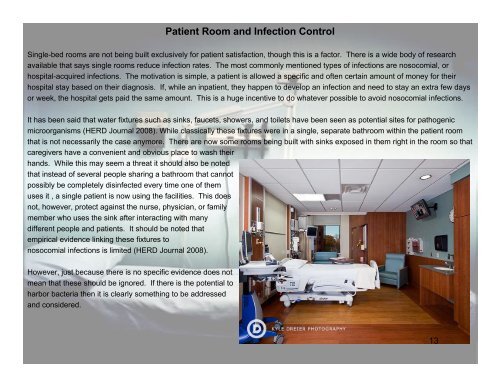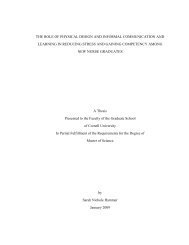The Patient Room: what is the ideal solution? - Cornell University
The Patient Room: what is the ideal solution? - Cornell University
The Patient Room: what is the ideal solution? - Cornell University
Create successful ePaper yourself
Turn your PDF publications into a flip-book with our unique Google optimized e-Paper software.
<strong>Patient</strong> <strong>Room</strong> and Infection Control<br />
Single-bed rooms are not being built exclusively for patient sat<strong>is</strong>faction, though th<strong>is</strong> <strong>is</strong> a factor. <strong>The</strong>re <strong>is</strong> a wide body of research<br />
available that says single rooms reduce infection rates. <strong>The</strong> most commonly mentioned types of infections are nosocomial, or<br />
hospital-acquired infections. <strong>The</strong> motivation <strong>is</strong> simple, a patient <strong>is</strong> allowed a specific and often certain amount of money for <strong>the</strong>ir<br />
hospital stay based on <strong>the</strong>ir diagnos<strong>is</strong>. If, while an inpatient, <strong>the</strong>y happen to develop an infection and need to stay an extra few days<br />
or week, <strong>the</strong> hospital gets paid <strong>the</strong> same amount. Th<strong>is</strong> <strong>is</strong> a huge incentive to do <strong>what</strong>ever possible to avoid nosocomial infections.<br />
It has been said that water fixtures such as sinks, faucets, showers, and toilets have been seen as potential sites for pathogenic<br />
microorgan<strong>is</strong>ms (HERD Journal 2008). While classically <strong>the</strong>se fixtures were in a single, separate bathroom within <strong>the</strong> patient room<br />
that <strong>is</strong> not necessarily <strong>the</strong> case anymore. <strong>The</strong>re are now some rooms being built with sinks exposed in <strong>the</strong>m right in <strong>the</strong> room so that<br />
caregivers have a convenient and obvious place to wash <strong>the</strong>ir<br />
hands. While th<strong>is</strong> may seem a threat it should also be noted<br />
that instead of several people sharing a bathroom that cannot<br />
possibly be completely d<strong>is</strong>infected every time one of <strong>the</strong>m<br />
uses it , a single patient <strong>is</strong> now using <strong>the</strong> facilities. Th<strong>is</strong> does<br />
not, however, protect against <strong>the</strong> nurse, physician, or family<br />
member who uses <strong>the</strong> sink after interacting with many<br />
different people and patients. It should be noted that<br />
empirical evidence linking <strong>the</strong>se fixtures to<br />
nosocomial infections <strong>is</strong> limited (HERD Journal 2008).<br />
However, just because <strong>the</strong>re <strong>is</strong> no specific evidence does not<br />
mean that <strong>the</strong>se should be ignored. If <strong>the</strong>re <strong>is</strong> <strong>the</strong> potential to<br />
harbor bacteria <strong>the</strong>n it <strong>is</strong> clearly something to be addressed<br />
and considered.<br />
13







